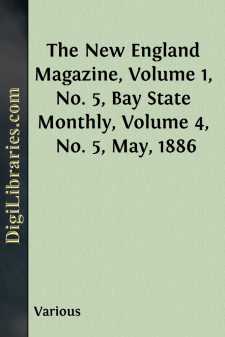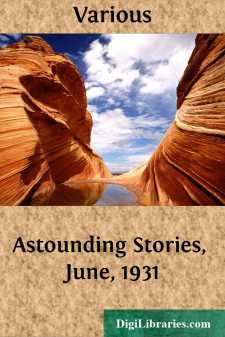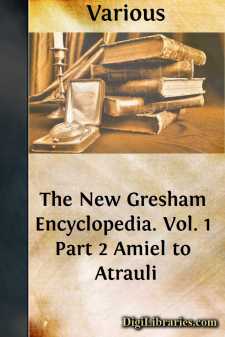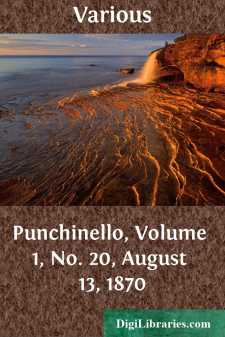Categories
- Antiques & Collectibles 13
- Architecture 36
- Art 48
- Bibles 22
- Biography & Autobiography 813
- Body, Mind & Spirit 138
- Business & Economics 28
- Children's Books 12
- Children's Fiction 9
- Computers 4
- Cooking 94
- Crafts & Hobbies 4
- Drama 346
- Education 46
- Family & Relationships 57
- Fiction 11821
- Games 19
- Gardening 17
- Health & Fitness 34
- History 1377
- House & Home 1
- Humor 147
- Juvenile Fiction 1873
- Juvenile Nonfiction 202
- Language Arts & Disciplines 88
- Law 16
- Literary Collections 686
- Literary Criticism 179
- Mathematics 13
- Medical 41
- Music 40
- Nature 179
- Non-Classifiable 1768
- Performing Arts 7
- Periodicals 1453
- Philosophy 64
- Photography 2
- Poetry 896
- Political Science 203
- Psychology 42
- Reference 154
- Religion 505
- Science 126
- Self-Help 81
- Social Science 81
- Sports & Recreation 34
- Study Aids 3
- Technology & Engineering 59
- Transportation 23
- Travel 463
- True Crime 29
The New England Magazine, Volume 1, No. 5, Bay State Monthly, Volume 4, No. 5, May, 1886
by: Various
Categories:
Description:
Excerpt
The plan for the establishment of a second college in Connecticut was not carried into effect until after the time of the political and religious revolution which secured the adoption of a State Constitution in 1818. Probably no such plan was seriously entertained till after the close of the war of Independence. The Episcopal church in Connecticut had, one may almost say, been born in the library of Yale College; and though Episcopalians, with other dissenters from the “standing order,” had been excluded from taking any part in the government or the instruction of the institution, they did not forget how much they owed to it as the place where so many of their clergy had received their education. In fact, when judged by the standards of that day, it would appear that they had at first little cause to complain of illiberal treatment, while on the other hand they did their best to assist the college in the important work which it had in hand. But Yale College, under the presidency of Dr. Clap, assumed a more decidedly theological character than before, and set itself decidedly in opposition to those who dissented from the Westminster Confession of Faith and the Saybrook Platform of Discipline. Besides, King’s College, which had been lately founded in New York, drew away some Episcopal students from Connecticut and made others dissatisfied; and had not the war with the mother country rudely put a stop to the growth of Episcopacy in the colony, it would seem that steps might have been soon taken for the establishment of some institution of learning, at least a school of theology, under the care of the clergy of the Church of England.
trinity college in 1828.
At any rate no sooner was it known that the war was ended than the churchmen of Connecticut sent the Rev. Dr. Seabury across the ocean to seek consecration as a bishop; and it was not long after his return that the diocese, now fully organized, set on foot a plan for the establishment of an institution of sound learning, and in 1795 the Episcopal Academy of Connecticut was founded at Cheshire. It was sometimes called Seabury College, and, under its learned principals, it fitted many young men for entrance upon their theological studies, and gave them part at least of their professional training. But its charter, which was granted by the General Assembly of the State in 1801, did not give it the power of conferring degrees, and the frequent petitions for an extension of charter rights, so as to make of the academy a collegiate institution, were refused. For a time, owing to determined opposition in the State, to the vacancy in the episcopate, and to other causes, the project was postponed. But a combination of events, social, political, and religious, led at length to the great revolution in Connecticut, in which all dissenters from the standing order united in opposition to it, and secured in 1818, though it was by a small majority, the adoption of a State Constitution containing a clause which admitted of “secession” from any ecclesiastical society and secured perfect religious equality before the law.
statue of bishop brownell,
on the campus.
In the following year, while the enthusiasm of the victory was still felt, the vacant episcopate was filled by the election of the Rev. Dr. Thomas Church Brownell, who had been for ten years tutor and professor in Union College, a man of learning, profoundly interested in education, and qualified for the varied duties which lay upon him as Bishop of Connecticut. He soon availed himself of this favorable opportunity for renewing the plans for the establishment of a college. There was much strong opposition to be encountered, and the student of the pamphlet literature of the day finds much to excite his interest and his wonder in the attacks upon the proposed “Second College in Connecticut”—“Seabury College,” as it was sometimes called. The whole matter was curiously complicated with discussions as to political and financial matters, the many questions between the recently disestablished order and its opponents not having been fully settled as yet. At last, on the 13th day of May, 1823, a petition for a college charter was presented to the General Assembly, and the act of incorporation of Washington College passed the lower house three days later, and soon received the assent of the senate and the approval of the governor. The name selected for the institution was not that which its friends would have preferred; but the honored name of Washington was adopted partly, as it would appear, because others than Episcopalians united in the establishment of the college, and partly that there could be no ground of opposition to it on account of its name....












